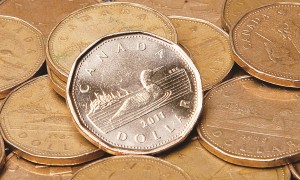What impact will current economic circumstances have on Canadian professional sports?
In just over six months, the price of oil has dropped from over one hundred dollars per barrel to under fifty dollars per barrel. A significant portion of the Canadian economy is dependent on oil. Over the same period of time, the Canadian dollar has dropped from a high of over ninety-four US cents to a low of under seventy-nine US cents. The weakening of the currency, and the economy generally, has of course had many important impacts, but this article will focus on what impact it will have on Canadian professional sports teams.

The weak Canadian dollar makes it even less likely that an NFL team will be moved to Toronto in the near future. It is simply more difficult to make money today, and the same issues that apply to the existing Canadian teams in other leagues would apply to this team.
The Toronto Raptors of the NBA are likely to be the least impacted of any of the teams, especially from a fan’s perspective. The NBA is structured in such a way that teams are obligated to spend within a certain narrow range on player salaries. A decrease in the Canadian dollar will not change what the Raptors spend on these salaries. The team may experience some decrease in profits because its main expense, player salaries, are in US dollars, when their main revenues, including ticket sales and Canadian TV, are in Canadian dollars. As the Canadian dollar decreases against the US, these revenues decrease. However, this will not necessarily be the case. A large portion of the Raptors’ revenues come from the NBA’s US national TV contract, which has grown significantly in recent years. The revenue for the owners of the Raptors (Bell and Rogers by way of MLSE) is also buoyed of late because of the team’s success on the court. More people watch the games on TV when the team is successful so advertisers are willing to pay more.
The Blue Jays are in a somewhat similar situation to the Raptors. They also receive a significant amount of money from their league’s US national TV deal, which has also increased in recent years. A significant portion of its revenue is also based on Canadian sources, which are less valuable with the low dollar. They are also owned by the same company that televises their games (Rogers), thus providing a corporate incentive to field a successful team. Where the Blue Jays differ from the Raptors is in the salary structure of their sport. MLB teams are left completely free to determine their payroll. With a decreasing Canadian dollar, many observers expect the Blue Jays to attempt to decrease expenses by not acquiring as many high level players as expected. To this point, in their off-season this appears to be exactly what is happening. Perhaps this approach is justified. To meet a payroll of 140 million US dollars the Blue Jays would have to spend approximately 180 million Canadian dollars, instead of the perhaps 145 million Canadian dollars that they likely budgeted. However, such cost cutting measures would likely result in the Blue Jays failing to field a sufficiently competitive team to retain fans, or bring in expected revenues. If revenue targets fall short, the payroll will likely be cut even further in response. The decrease in the dollar therefore appears to be especially damaging to the Blue Jays.
The current economy has a unique impact on the NHL. Seven of the NHL’s thirty teams are based in Canada, proportionately far more than any other sport. The NHL is far more popular in Canada than it is anywhere in the US. Therefore, a much larger portion of the entire league’s revenue comes from Canada, and in the form of Canadian dollars. However, player salaries are calculated in US dollars, as is the salary cap. The salary cap is currently sixty-nine million US dollars. In December, league commissioner Gary Bettman indicated that he expected the salary cap to rise to seventy-three million dollars next year. Yet this figure was acknowledged to be largely dependent on the Canadian dollar. At the time the Canadian dollar was at eighty-eight cents US. It would be reasonable to expect the cap to be lower than that estimated figure if the Canadian dollar remains lower than that level. That provides difficulty to many teams and players. In planning contracts, teams generally assume that the salary cap will rise. This allows them to accommodate raises for their existing players and continue to sign new free agent players. If the cap does not increase as expected, many of these teams will not be able to sign the players that they otherwise would have hoped for. From the perspective of the players, it is also a problem. Players entering free agency will not be able to find teams with enough room under their salary caps to pay them what they would otherwise be worth.
I am sure the drop in oil and the connected drop in the Canadian dollar has had similar impacts on other industries, but none of these other industries are likely to impact the way that I spend my free time as much as these professional leagues. Let us hope the loonie bounces back for the sake of our favorite team – OK, maybe also for the value of our bank accounts.
